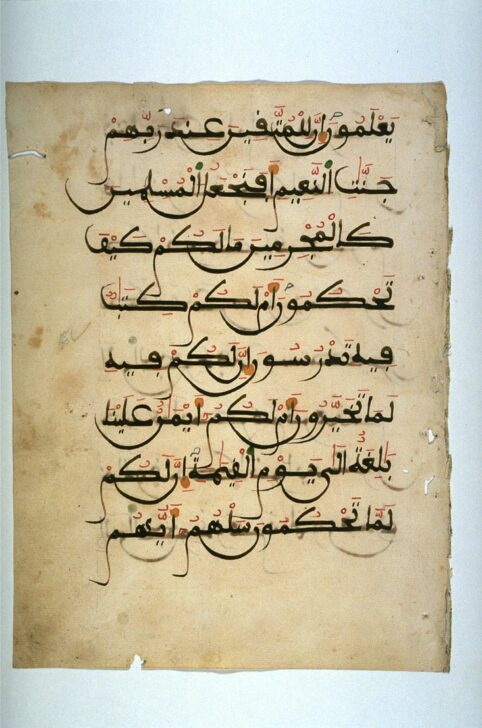Manuscript page from a Qur’an, from Sura 68

Description
Part of the same manuscript 1959/1.146
---
Leaf from a Qur’an manuscript, Sura (section) 68, verses 34–9
North Africa
Possibly 13th century
Ink with touches of red, ochre, and green on paper
Gift of Mr. and Mrs. Milton B. Freudenheim in memory of Otto F. Ege, 1987/1.195.2
“There will be Gardens of bliss for those who are mindful of God.
Should We treat those who submit to Us as We treat those who do evil?
What is the matter with you? On what basis do you judge?
Do you have a scripture that tells you
That you will be granted whatever you choose?
Have you received from Us solemn oaths, binding to the Day of the Resurrection, that you will get whatever you yourselves decide?”
English translation of Qur’an, Sura (section) 68, verses 34–9,
by Abdel Haleem
For Muslims, Arabic script, representing the language of their holy book, the Qur’an, is a thing of sublime beauty. Arabic calligraphy links the spiritual and aesthetic dimensions of the written work and figures significantly in the visual and healing arts of the Islamic world.
There are many styles of Arabic calligraphy. This page from a North African Qur’an is written in a script called Maghribi, which was developed in the western region of North Africa. Maghribi is a variation of the ancient Kufic script, known for its angular form. Maghribi script features sweeping curves that soften the angularity of its Kufic characters. Diacritical marks indicated in red facilitate the reading of this script.
(6/29/10)
Gallery Rotation Spring/Summer 2010
Leaf from a Qur’an manuscript, Sura (section) 68, verses 34–9
North Africa
Possibly 13th century
Ink with touches of red, ochre, and green on paper
Gift of Mr. and Mrs. Milton B. Freudenheim in memory of Otto F. Ege, 1987/1.195.2
“There will be Gardens of bliss for those who are mindful of God.
Should We treat those who submit to Us as We treat those who do evil?
What is the matter with you? On what basis do you judge?
Do you have a scripture that tells you
That you will be granted whatever you choose?
Have you received from Us solemn oaths, binding to the Day of the Resurrection, that you will get whatever you yourselves decide?”
English translation of Qur’an, Sura (section) 68, verses 34–9,
by Abdel Haleem
For Muslims, Arabic script, representing the language of their holy book, the Qur’an, is a thing of sublime beauty. Arabic calligraphy links the spiritual and aesthetic dimensions of the written work and figures significantly in the visual and healing arts of the Islamic world.
There are many styles of Arabic calligraphy. This page from a North African Qur’an is written in a script called Maghribi, which was developed in the western region of North Africa. Maghribi is a variation of the ancient Kufic script, known for its angular form. Maghribi script features sweeping curves that soften the angularity of its Kufic characters. Diacritical marks indicated in red facilitate the reading of this script.
Subject Matter:
Maghribi script originated in North Africa and has been used for centuries to write the Qur'an, the foundational book in Islam. The paper was imported from Spain, but the manuscript was assembled and written in North Africa, possibly in Morocco.
The elaborate calligraphic script in Arabic communicated the importance of this text to readers. The yellow and green marks indicate the pronunciation of words and signal particular initials. The red marks provide even more guidance in pronouncing and deciphering the text; it is possible these marks were made by a later owner after the manuscript was originally written.
The two sides of this page contain parts of the 68th sura (chapter) of the Qur'an.
Usage Rights:
If you are interested in using an image for a publication, please visit https://umma.umich.edu/request-image/ for more information and to fill out the online Image Rights and Reproductions Request Form.